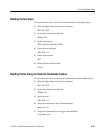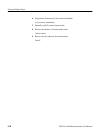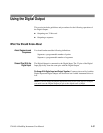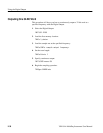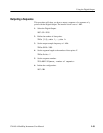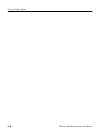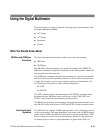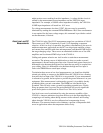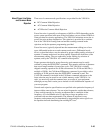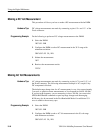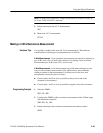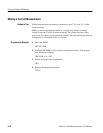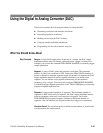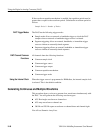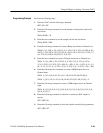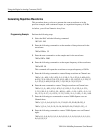
Using the Digital Multimeter
VX4101A MultiPaq Instrument User Manual
2–43
Three sets of common mode specifications are provided for the VX4101A:
H DC Common Mode Rejection
H AC Common Mode Rejection
H AC Effective Common Mode Rejection
Power line noise is generally at a frequency of 60 Hz or 50 Hz depending on the
power system prevalent in the area of the world where you are located. 400 Hz is
often prevalent in avionics applications. The VX4101A minimizes errors due to
power line noise at these frequencies. This rejection is provided by a combina-
tion of the VX4101A floating front end and the resulting common mode
rejection, and by the aperture programming provided.
Power line errors (typically injected into the measurement cabling) are of two
types, differential mode errors and common mode errors. Differential mode
errors, as described above, may be reduced by proper cabling and by selection of
aperture. Common mode errors are those equally injected onto both lines of the
measurement cabling. They are reduced by proper cabling, by selection of
aperture, and by the VX4101A AC common mode rejection.
Proper aperture selection for power line noisy environments may be easily
selected by using the SENS:NPLC command. This permits selection of apertures
that are an integer number of power line cycles. The VX4101A is initially
shipped assuming operation in a 60 Hz environment. For 50 Hz and 400 Hz (a
multiple of 50 Hz), the CALibrate:LFRequency command is provided to select
multiples of 50 Hz periods when the SENS:NPLC command is used. The
CAL:LFR command is included in the CALibrate command subsystem so the
latest selection may be stored in non-volatile memory on the VX4101A. As
such, you need only send the command once on receipt of your equipment,
although you may find it easier just to include it in the initialization sequence of
your test program.
Normal mode rejection specifications are specified at the particular frequency of
interest within some tolerance. You can reject frequencies outside that tolerance,
if they are high enough, by choosing an aperture that is a multiple of that
frequency, or for broadband noise by choosing as large an aperture as is
consistent with test time requirements. The amount of rejection for any
frequency and aperture may be determined by integrating the noise signal over
the aperture time and determining the resulting DC error.
About Power Line Noise
and Common Mode
Rejection



